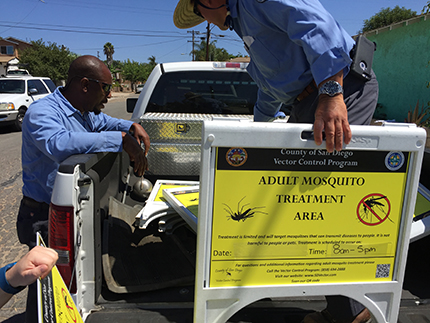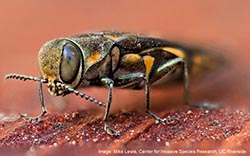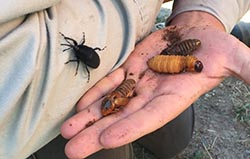InTouch – How We Work the Bugs Out
/ Try to shoo away flies, stop ants invading your kitchen, or keep fleas off your dog, and you’ll know how persistent and irritating insects can be.
Try to shoo away flies, stop ants invading your kitchen, or keep fleas off your dog, and you’ll know how persistent and irritating insects can be.
If you’re lucky, the bugs you deal with are just an annoyance. But they’re often far more than that. Some pose serious threats to the region – to people’s health, to the environment, to our local economy.
You know that protecting the public is at the core of what we do, but you may not be aware how much of that involves watching for and battling insects. I wanted to talk a little about a few of the major concerns we face here and the variety of important roles the County plays in keeping us safe from these tiny troublemakers.
It used to be that the most San Diegans had to fear from mosquitoes was a bad itch. Now we’re on guard against the Zika and West Nile viruses, both carried by mosquitoes.
 Vector Control staff Sean Simmons (left) and Steve Rivera prepare to treat a neighborhood for mosquitoes last year. You probably saw news coverage last year of our County Vector Control teams treating neighborhoods to kill mosquitoes. They do that when the types of mosquitoes that spread Zika are found near the home of a person with the virus. So far, all the local Zika cases have originated outside the county. Our teams are trying to keep mosquitoes from spreading it here.
Vector Control staff Sean Simmons (left) and Steve Rivera prepare to treat a neighborhood for mosquitoes last year. You probably saw news coverage last year of our County Vector Control teams treating neighborhoods to kill mosquitoes. They do that when the types of mosquitoes that spread Zika are found near the home of a person with the virus. So far, all the local Zika cases have originated outside the county. Our teams are trying to keep mosquitoes from spreading it here.
Zika may grab more headlines, but West Nile remains a danger. It can make people extremely sick, and even kill. Two people died from the virus here last year, six the year before that.
Vector Control employees have been working relentlessly to keep the disease-carrying mosquitoes at bay. One of their best tools is education: making sure the public is aware of the danger and knows steps to protect themselves. You’ll find everything you need to know on SDFightTheBite.com.
Especially with the peak of mosquito season approaching, you can really help by spreading the message yourself. If you’re at a friend’s backyard barbecue and see containers with standing water, let them know that’s where mosquitoes can breed. Know someone visiting a country where Zika is active? Remind them to protect themselves. It’s for their own and the public’s safety.
Which county in America has the most farms? Believe it or not, it’s San Diego. According to the San Diego County Farm Bureau, agriculture has a $5 billion annual impact on the local economy, and we’re on constant guard against invasive pests that could take a bite out of it, figuratively if not literally. On the most wanted list: the Asian citrus psyllid, which spreads the world’s worst citrus disease. The glassy-winged sharpshooter, spreading disease to our grapes, among others food crops. And various invasive fruit flies that can ruin all kinds of fruits and vegetables.
 Insect detection specialist Brian Burkman inspects a trap in a local vineyard several years ago.Early detection of these pests is essential. So Agriculture, Weights and Measures staff are in the field constantly, doing hundreds of thousands of inspections each year of tens of thousands of traps. If harmful pests are found, staff moves quickly to eradicate them and keep them from spreading.
Insect detection specialist Brian Burkman inspects a trap in a local vineyard several years ago.Early detection of these pests is essential. So Agriculture, Weights and Measures staff are in the field constantly, doing hundreds of thousands of inspections each year of tens of thousands of traps. If harmful pests are found, staff moves quickly to eradicate them and keep them from spreading.
AWM also has help from a pest detector's best friends: two dog teams they take to major package distribution terminals. The dogs are trained to sniff out produce and plant materials, and their sensitive noses have stopped many packages carrying potentially dangerous insects from moving around the county.
Bad bugs attack not just what we grow but also plants growing naturally, changing the landscape that we love. Beetles called shot hole borers have been wreaking havoc on trees around Southern California. Locally, it's been hitting trees in the Tijuana River Valley particularly hard. Our Parks department works with AWM and other partners to treat or remove infected trees. And Parks is working to protect our tree canopy with a “no net loss” program for park trees – meaning for each tree that is lost to bugs or drought, two new trees are planted.
 A gold spotted oak borerThat's in addition to the more established gold spotted oak borer, which has claimed tens of thousands of oaks around the county for years now, including many in County parks. One of the only defenses is up to all you campers out there - don't move firewood. The beetles can infest it, then hitch a ride if you transport the wood and find new trees to attack. The watchwords are "buy it where you burn it."
A gold spotted oak borerThat's in addition to the more established gold spotted oak borer, which has claimed tens of thousands of oaks around the county for years now, including many in County parks. One of the only defenses is up to all you campers out there - don't move firewood. The beetles can infest it, then hitch a ride if you transport the wood and find new trees to attack. The watchwords are "buy it where you burn it."
 South American palm weevils are shown here in various stages of development.And there’s a new, much larger insect – the South American palm weevil – that is just now entering San Diego’s south county. Tree loss has been minimal, but the bug travels fast and far, burrowing into the top of the palm and damaging its crown or heart. LUEG teams are developing a coordinated approach to address the removal of infected trees.
South American palm weevils are shown here in various stages of development.And there’s a new, much larger insect – the South American palm weevil – that is just now entering San Diego’s south county. Tree loss has been minimal, but the bug travels fast and far, burrowing into the top of the palm and damaging its crown or heart. LUEG teams are developing a coordinated approach to address the removal of infected trees.
Threaded through a lot of this work is the UC Cooperative Extension, a partnership joining the County, the University of California and state and federal agriculture experts. They help with research, education and strategies for fighting pests.
I just barely scratched the surface of the insect threats we’re facing and ways we’re responding. But I do want you to think of these members of our County team the next time you’re cutting into an avocado from North County or hiking a tree-shaded trail. And when they explain things the public can do to help, let’s make sure we do them. Lives and livelihoods depend on it.
And however you’re enjoying your summer – on the patio, at a picnic, around a campfire – may it be bug-free!
Recent InTouch columns
Here's What We're Doing to Promote Diversity & Inclusion